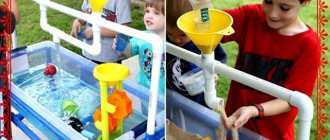Senior group
Games for older preschoolers should be aimed at developing logical thinking, speech, intelligence, curiosity, and perseverance. At this age, children must classify plants according to different characteristics, and preparation for school begins.
Turning into a flower
The game strengthens the facial muscles and promotes overall physical development.
Invite the students to use facial expressions and body movements to depict a flower, how it opens its petals, reaches out to the sunlight, bends its stem under the raindrops, and closes for the night.
Name the odd one out
For the game, prepare groups of cards: meadow species, forest, field, garden, water. There are 4 plants in each group, one of them does not correspond to the category. Lay out the cards in front of the players, ask them to name the extra type and explain their opinion.
For example: rose, tulip, clover, peony. Clover is not a garden plant, but a meadow plant.
Flowers
In addition to getting to know plants, the goal of the didactic game “Flowers” is physical training, developing dexterity and a sense of rhythm.
The children take turns playing. The player takes the ball, hits it on the floor or wall, catches it, and names a plant with each hit. He must name 5 species. You can't repeat yourself. If a player cannot remember the plant, then he gives the ball and the right to play to the next player.
Name the adjective
The game develops the skill of forming adjectives from nouns. Name the flower and the object. The player must name an adjective that is a qualitative attribute of this object:
- poppy, and the grain... poppy;
- chamomile, and the field... chamomile;
- a rose, and the bud... pink;
- acacia, and honey... acacia;
- cornflower, and the eyes... cornflower blue;
- dandelion, and the jam... dandelion.
Junior group
For younger preschoolers, simple educational, active and musical games are recommended.
Post a flower
Make two paper daisies for the game with the petals separated from the core. The number of petals must correspond to the number of players. Place daisies on the floor near the wall. Divide the students into 2 groups with an equal number of players.
Invite teams to move their daisy to the opposite wall. Each player transfers only one part of the plant: the first - the yellow core, the second - the petal, and so on. A player is not allowed to take two petals at once. The next participant starts moving when the previous one returns to the start. The team that collects its daisy first wins.
Collect a bouquet
Before playing, tell the children what parts flowers are made of: core, petals, stems and leaves. Cut out plant parts from colored paper and glue them into a bouquet arrangement, but do not glue the petals. Make petals of a certain color from the main spectrum for each flower. Tell the students that the wind tore off the petals, which now need to be selected according to the color for each plant in the bouquet.
Bells
Children choose a leader by lot. He leaves the room. The players hide a picture depicting a blooming bell in the game room, disassemble the musical instruments themselves - small bells, and distribute them throughout the room. Moreover, one of the players must stand close to the hidden image.
The presenter enters the playroom, begins to walk around it, and approaches the children. When he approaches a player who is standing far from the picture, he does not ring the bell. When he approaches a participant standing closer to the picture, he makes a quiet ringing sound. The leader approaches the target even closer - the player makes a louder sound. The participant closest to the others rings the loudest. This way the presenter understands where to go in searching for the picture.
A flower is blooming
The game is educational. First tell the children how flowers bloom in nature. Prepare plant templates and distribute to students. Show how to curl the petals. Let the children put the flowers in a glass of water and observe what happens to the petals. When exposed to moisture, the petals will begin to “bloom.”
Middle group
Older preschoolers should know where flowers grow, what features and properties different types of plants have. It is important to instill in students a love for the nature of their native land. We must not forget about the physical activity of the children.
Where does the flower grow
For the game, prepare pictures of flower beds, fields, forests. Make cards depicting flowers familiar to the children. Invite the players to distribute the cards according to the pictures of growing places.
Flower drawing competition
By participating in an art competition, children develop imagination, creative skills, and color perception.
For the competition, purchase or pick a large flower from your garden: tulip, peony, rose, sunflower, iris or other. Children prepare art supplies and sit at easels, if available, or tables. From the finished works they put together an exhibition and choose the winner of the competition whose work they liked the most.
Flowers
The didactic game “Flowers” develops speech skills, imaginative thinking, and the ability to select descriptive features.
Ask a question and let the children give descriptions. You cannot repeat yourself; for each correct answer the player receives a point. The participant with the most points wins.
Here are sample questions:
- What kind of rose? – beautiful, red, lush, fragrant, tender;
- What flowers have spines? – rose, rose hip, cactus, blackthorn, burdock;
- What flowers are perfume made from? – jasmine, lavender, rose, lily of the valley, peony;
- What plants are honey made from? – dandelion, linden, acacia, clover;
- What flowers are yellow? – sunflower, dandelion, narcissus, buttercup.
Flower catch-up
Each player chooses the name of the flower; they should not be repeated. The players decide by lot who is catching up. Let it be “Cornflower”. He names some other plant, for example, “Dandelion”. The player who chose the name “Dandelion” runs away. "Cornflower" catches up with him. When “Dandelion” feels like it is about to be overtaken, it may say out loud another flower, such as “Chamomile.” Then “Romashka” has to run away, “Cornflower” switches to her. If “Dandelion” does not have time to pronounce the word and is caught, then it becomes catching up.
Card index of didactic games.
D/game “Arrange the shapes by color.”
Goal: to consolidate ideas about six colors, to consolidate the names of the colors of the spectrum.
D/game “Assemble a pyramid of rings.”
Goal: to consolidate ideas about relationships in form, to teach them to arrange them in descending order.
D/game “Assemble a matryoshka doll.”
Goal: to teach children to establish the relationship of objects by size.
D/game “Collect vegetables”.
Goal: to introduce children to shapes: circle and oval; learn to examine geometric shapes (trace the contours with your finger).
D/game “Who has the same?”
Goal: to consolidate children’s ideas about geometric shapes and practice naming them.
D/game “Put the barrels”.
Goal: to consolidate the ability to establish relationships between objects by size.
D/game “Collect fruits by color.”
Goal: to teach children to group objects that differ in shape and size, but have the same color.
D/game “Find the same one.”
Goal: to teach children to group objects that have the same shape.
D/game “Arrange the apples by size.”
Goal: to develop an eye when choosing objects of a certain size based on a model.
D/game “Hide the mouse”.
Goal: to consolidate children's knowledge about the six colors of the spectrum and their names.
D/game “Find something round.”
Goal: to consolidate ideas about shapes, to teach how to select shapes according to a model.
D/game “Assemble a turret”.
Goal: to consolidate ideas about relationships by size, to teach them to arrange them in descending order.
D/game “What does a beautiful doll need?”
Goal: to give children an idea that color is a sign of a variety of objects and can be used to designate them.
D/game “Collect beads”.
Goal: learn to alternate objects according to shape.
D/game “Choose clothes for the doll.”
Goal: match objects by size.
D/game “Match the car by color.”
Goal: To consolidate the ability to group objects by color and teach children to correlate dissimilar objects by color.
D/game “Find an object of the same shape.”
Goal: to teach children to identify the shape of specific environmental objects using geometric patterns.
D/game “Find the same ring.”
Goal: to teach children to find two objects of the same size by overlapping.
D/game “Pick according to the shape.”
Goal: to teach children to highlight the shape of an object, distracting from other signs.
D/game “What did Mishutka bring?”
Goal: to form ideas about geometric shapes
D/game." Match the cups to the saucers."
Goal: To teach children to distinguish colors and use color names in speech. Develop fine motor skills and attention.
D/game “Place the pieces in their places!”
Goal: Continue to introduce flat geometric shapes - square, circle, triangle, oval, rectangle. Learn to select the right shapes using different methods.
D/game “Natasha’s doll’s housewarming party.”
Goal: to teach children to determine the size of an object.
D/game “Let’s decorate the Christmas tree.”
Goal: group colors, select them according to the word denoting color.
D/game “Pick a figure”.
Goal: to consolidate children’s ideas about geometric shapes and practice naming them.
D/game “Tower of cubes”.
Goal: to teach children to compare several objects by size and arrange them in decreasing order of size.
D/game "Open your castle."
Goal: To train children in the ability to compare colors, to help consolidate knowledge and the color system.
D/game "Put the fish in the aquarium."
Goal: To teach to distinguish objects based on two characteristics (shape and size).
D/game “Arrange the dogs by height.”
Goal: to teach children to arrange objects in descending order.
D/game "Washing machines."
Goal: To develop the ability to distinguish and name primary colors.
D/game “It’s the bunny’s birthday, let’s prepare a treat.”
Goal: to teach children to group geometric shapes (ovals and circles) by shape, distracting from color and size.
D/game “Hide the ball in your palms.”
Goal: relate actions to magnitude.
D/game "Polyanka."
Purpose: To establish identities and differences in color of homogeneous objects. Learn to understand the words “color”, “like this”, “not like this”, “different”.
Preparatory group
At this age, kindergarteners are preparing for school. They must have narration skills, tell from memory and visual material. It is important, with the help of games, to develop imagination, memory, spatial and color perception in future schoolchildren, to cultivate communication skills, a sense of beauty, the ability to build a dialogue, attentiveness, and perseverance.
What kind of flower are you?
Invite the students to “turn” into flowers. Each player chooses what kind of plant to become, but does not tell his comrades about it. Children take turns coming forward, depicting their flower using facial expressions and body movements, without uttering a word. The rest of the guys must guess what plant we are talking about.
Flower shop
For the game, prepare natural or artificial flowers. Children act as florists. The game is collective and teaches communication, teamwork, and organization.
The students make up a beautiful bouquet. Then they try to sell it to the teacher. At the same time, they must praise the bouquet, explain what plants were used, why they chose them, and for what purpose the flower arrangement is intended.
Flower names
The players form a circle. The teacher stands in the center, throws the ball to each child in turn, saying a name or an object named similar to a flower. The player who catches the ball must name the corresponding plant. For example: Vasily - cornflower, nail - carnation, Roman - chamomile, jug - water lily, Lilya - lily, Violetta - viola, toffee - iris. The player who finds it difficult to answer is eliminated from the circle.





